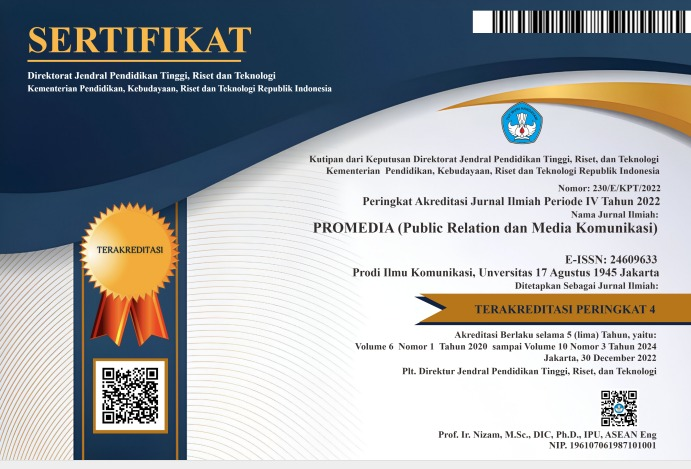Komunikasi sebagai Katalis Membangun Resiliensi pada Individu dan Komunitas : Tinjauan Pustaka Sistematis
Abstract
Tinjauan pustaka sistematis ini menyajikan mengenai peran komunikasi dalam membangun ketahanan, baik pada tingkat individu maupun komunitas. Dengan menggunakan protokol PRISMA, penelitian ini mengungkap 53 artikel ilmiah yang secara eksplisit menguraikan hubungan antara komunikasi dan resiliensi, dipublikasikan antara tahun 2016 hingga 2023 di jurnal berbahasa Inggris. Tinjauan ini bertujuan untuk menjawab tiga pertanyaan utama: penelitian karakteristik komunikasi-resiliensi, peran komunikasi dalam mendukung individu menghadapi stres dan trauma, serta kontribusi komunikasi dalam memperkuat ketahanan kolektif dalam komunitas. Hasil penelitian menunjukkan bahwa komunikasi tidak hanya berfungsi sebagai media informasi, tetapi juga sebagai mekanisme utama dalam proses adaptasi psikososial, pembentukan makna, dukungan emosional, serta pemulihan. Pada tingkat individu, komunikasi berperan dalam memperkuat identitas, membentuk harapan, serta memfasilitasi ekspresi dan pengelolaan emosi yang sehat. Pada tingkat komunitas, komunikasi mendorong partisipasi warga, membangun jaringan dukungan sosial dan kerelawanan, serta memperkuat koordinasi respons dalam situasi krisis. Kajian ini juga mengungkap bahwa konteks penelitian masih didominasi oleh negara-negara maju, khususnya Amerika Serikat, sehingga diperlukan kontribusi yang lebih luas dari wilayah Global South untuk memperkaya perspektif lokal dalam sastra global. Temuan ini menegaskan bahwa komunikasi adalah kunci dalam membangun ketahanan yang berkelanjutan, dan memberikan dasar konsep bagi pengembangan strategi komunikasi dalam penanganan krisis dan pemberdayaan masyarakat.
References
Afifi, T., Collins, N., Rand, K., Otmar, C., Mazur, A., Dunbar, N. E., Fujiwara, K., Harrison, K., & Logsdon, R. (2023). Using Virtual Reality to Improve the Quality of Life of Older Adults with Cognitive Impairments and their Family Members who Live at a Distance. Health Communication, 38(9), 1904–1915. https://doi.org/10.1080/10410236.2022.2040170
Afifi, T. D., Callejas, M. A., & Harrison, K. (2020). Resilience through stress: The theory of resilience and relational load. In L. Aloia S, A. Denes, & J. P. Crowley (Ed.), The Oxford Handbook of the Physiology of Interpersonal Communication (hal. 210–234). Oxford University Press. https://doi.org/10.1093/oxfordhb/9780190679446.013.11
Afifi, T. D., Zamanzadeh, N., Harrison, K., & Torrez, D. P. (2020). Explaining the impact of differences in voting patterns on resilience and relational load in romantic relationships during the transition to the Trump presidency. Journal of Social and Personal Relationships, 37(1), 3–26. https://doi.org/10.1177/0265407519846566
Agarwal, V., & Buzzanell, P. M. (2015). Communicative Reconstruction of Resilience Labor: Identity/Identification in Disaster-Relief Workers. Journal of Applied Communication Research, 43(4), 408–428. https://doi.org/10.1080/00909882.2015.1083602
Andreasen, A. J., Johnson, M. K., & Tranel, D. (2024). Stability of Psychological Well-being Following a Neurological Event and in the Face of a Global Pandemic. Rehabilitation Counseling Bulletin, 67(3), 190–206. https://doi.org/10.1177/00343552221139878
Boumis, J. K., Kuang, K., Wilson, S. R., Hintz, E. A., & Buzzanell, P. M. (2023). Family Communication Patterns Predict Anticipatory Resilience and the Enactment of Resilience Processes. Journal of Family Communication, 23(1), 22–40. https://doi.org/10.1080/15267431.2023.2172021
Bradley, N., Dowrick, C., & Lloyd-Williams, M. (2023). Explaining how and why social support groups in hospice day services benefit palliative care patients, for whom, and in what circumstances. Palliative Care and Social Practice, 17. https://doi.org/10.1177/26323524231214549
Buzzanell, P. M. (2010). Resilience: Talking, Resisting, and Imagining New Normalcies Into Being. Journal of Communication, 60(1), 1–14. https://doi.org/10.1111/j.1460-2466.2009.01469.x
Buzzanell, P. M., & Houston, J. B. (2018). Communication and resilience: multilevel applications and insights–A Journal of Applied Communication Research forum. Journal of Applied Communication Research, 46(1), 1–4. https://doi.org/10.1080/00909882.2017.1412086
Cayamanda, K. J. (2020). Exploring a Social Vulnerability Model for Disaster Studies: The Case of the 2011 Flashflood in Davao City, Southern Philippines. International Journal of Educational Management and Development Studies, 1(1), 43–75. https://doi.org/10.53378/346006
Chee Yin, H., Kassem, M. M., & Mohamed Nazri, F. (2022). Comprehensive Review of Community Seismic Resilience: Concept, Frameworks, and Case Studies. Advances in Civil Engineering, 2022(1). https://doi.org/10.1155/2022/7668214
Craig, E. A., Nieforth, L., & Rosenfeld, C. (2020). Communicating Resilience among Adolescents with Adverse Childhood Experiences (ACEs) through Equine Assisted Psychotherapy (EAP). Western Journal of Communication, 84(4), 400–418. https://doi.org/10.1080/10570314.2020.1754451
Creswell, J. W. (2014). Research Design Qualitative, Quantitative ad Mixed Methods Approaces (J. W. Cresswell (ed.); 4 ed.). SAGE Publications Ltd.
Cueto, R. M., Fernández, M. Z., Moll, S., & Rivera, G. (2015). Community Participation and Strengthening in a Reconstruction Context After a Natural Disaster. Journal of Prevention & Intervention in the Community, 43(4), 291–303. https://doi.org/10.1080/10852352.2014.973296
Denes, A., Cornelius, T., Webber, K. T., Guest, C., Ellis, J. A., & Gorin, A. A. (2023). Living through the pandemic together: Exploring the associations among couples’ communal orientation, self-disclosure, and thriving. Journal of Social and Personal Relationships, 40(11), 3563–3584. https://doi.org/10.1177/02654075231175694
Dhillon, A., & Lambertz-Berndt, M. (2023). Working Parents’ Struggling to Achieve the Work-Life Balance During the Pandemic: Exploring the Benefits of Relational Maintenance Beyond Relational Outcomes. Southern Communication Journal, 88(3), 211–228. https://doi.org/10.1080/1041794X.2023.2187074
Dorrance-Hall, E., & Scharp, K. M. (2021). Communicative predictors of social network resilience skills during the transition to college. Journal of Social and Personal Relationships, 38(4), 1238–1258. https://doi.org/10.1177/0265407520983467
Fanari, A., Cooper, R. A., Dajches, L., Beck, G., & Pitts, M. J. (2023). Transferable Resilience Practices: Communication and Resilience of U.S. Military Spouses during the Initial Stages of the COVID-19 Pandemic. Journal of Family Communication, 23(1), 1–21. https://doi.org/10.1080/15267431.2022.2149528
Finucane, M. L., Acosta, J., Wicker, A., & Whipkey, K. (2020). Short-Term Solutions to a Long-Term Challenge: Rethinking Disaster Recovery Planning to Reduce Vulnerabilities and Inequities. International Journal of Environmental Research and Public Health, 17(2), 482. https://doi.org/10.3390/ijerph17020482
Gayatri, M., & Irawaty, D. K. (2022). Family Resilience during COVID-19 Pandemic: A Literature Review. The Family Journal, 30(2), 132–138. https://doi.org/10.1177/10664807211023875
Geary, D., Scharp, K., & Manusov, V. (2023). Life interrupted instead of disrupted: triggers and resilient communication processes revealed in POZ.com online narratives by men with HIV who have sex with men. Journal of Applied Communication Research, 51(1), 91–108. https://doi.org/10.1080/00909882.2022.2099227
Gerhart, J., O’Mahony, S., Abrams, I., Grosse, J., Greene, M., & Levy, M. (2016). A pilot test of a mindfulness-based communication training to enhance resilience in palliative care professionals. Journal of Contextual Behavioral Science, 5(2), 89–96. https://doi.org/10.1016/j.jcbs.2016.04.003
Goldie, K., Ironside, R., & Pirie, E. (2023). “It feels real”: Events management and online experiential learning in COVID-19. Distance Education, 44(2), 230–245. https://doi.org/10.1080/01587919.2023.2198490
Hormann, S. (2018). Exploring Resilience: in the Face of Trauma. Humanistic Management Journal, 3(1), 91–104. https://doi.org/10.1007/s41463-018-0035-0
Horstman, H. K., Pedro, A., Goldschmidt, T., Watson, O., Butauski, M., & Pedro Tessa Goldschmidt, A. (2023). Exploring Resilience and Communicated Narrative Sense-Making in South Africans’ Stories of Apartheid. In International Journal of Communication (Vol. 17). http://ijoc.org.
Houston, J. B., & Buzzanell, P. M. (2018). Communication and resilience: concluding thoughts and key issues for future research. Journal of Applied Communication Research, 46(1), 26–27. https://doi.org/10.1080/00909882.2018.1426691
Houston, J. B., & Buzzanell, P. M. (2020). Communication and resilience: introduction to the Journal of Applied Communication Research special issue. Journal of Applied Communication Research, 48(1), 1–4. https://doi.org/10.1080/00909882.2020.1711956
Hyvärinen, J., & Vos, M. (2015). Developing a Conceptual Framework for Investigating Communication Supporting Community Resilience. Societies, 5(3), 583–597. https://doi.org/10.3390/soc5030583
Ihm, J., & Lee, C.-J. (2023). Communication Networks and Individual Resilience for Individual Well-Being During a Time of Crisis. Health Communication, 38(14), 3178–3192. https://doi.org/10.1080/10410236.2022.2141041
Jiang, Q., Zhang, Y., & Pian, W. (2022). Chatbot as an emergency exist: Mediated empathy for resilience via human-AI interaction during the COVID-19 pandemic. Information Processing and Management, 59(6). https://doi.org/10.1016/j.ipm.2022.103074
King, J., Kam, J. A., Cornejo, M., & Mendez Murillo, R. (2023). Enacting resilience at multiple levels during the COVID-19 pandemic: exploring communication theory of resilience for U.S. undocumented college students. Journal of Applied Communication Research, 51(5), 539–558. https://doi.org/10.1080/00909882.2023.2178855
Kingsford, A. N., Gist-Mackey, A. N., & Pastorek, A. E. (2022). Welfare recipients communicated pathways to resilience during stigma and material hardship in the heartland of America. Journal of Applied Communication Research, 50(4), 363–381. https://doi.org/10.1080/00909882.2021.1987504
Kuang, K., Tian, Z., Wilson, S. R., & Buzzanell, P. M. (2023). Memorable Messages as Anticipatory Resilience: Examining Associations among Memorable Messages, Communication Resilience Processes, and Mental Health. Health Communication, 38(6), 1136–1145. https://doi.org/10.1080/10410236.2021.1993585
Kuang, K., Wilson, S. R., Tian, Z., & Buzzanell, P. M. (2022). Development and validation of a culturally adapted measure of communication resilience processes for Chinese contexts. International Journal of Intercultural Relations, 91(July), 70–87. https://doi.org/10.1016/j.ijintrel.2022.09.003
Kuntz, J. C. (2021). Resilience in Times of Global Pandemic: Steering Recovery and Thriving Trajectories. Applied Psychology, 70(1), 188–215. https://doi.org/10.1111/apps.12296
LaFreniere, J. R. (2022). Examining young adults’ emotional labor as a form of relational load with parents. Communication Research Reports, 39(3), 160–170. https://doi.org/10.1080/08824096.2022.2073989
Latzoo, C. (2021). Communicative Resilience as Interpretive Response: An Existential-Phenomenology of Reintegration. Southern Communication Journal, 86(3), 189–200. https://doi.org/10.1080/1041794X.2021.1901303
Lee, S.-H., Kim, D.-H., & Kang, K. (2022). Effects of cultural adaptation resilience promotion program for mothers-in-law in multicultural families. PLOS ONE, 17(9), e0274224. https://doi.org/10.1371/journal.pone.0274224
Longstaff, P. H., & Yang, S.-U. (2008). Communication Management and Trust: Their Role in Building Resilience to “Surprises” Such As Natural Disasters, Pandemic Flu, and Terrorism. Ecology and Society, 13(1), art3. https://doi.org/10.5751/ES-02232-130103
Lucas, K., & Buzzanell, P. M. (2012). Memorable Messages of Hard Times: Constructing Short- and Long-Term Resiliencies Through Family Communication. Journal of Family Communication, 12(3), 189–208. https://doi.org/10.1080/15267431.2012.687196
Luu, T. T. (2021). Activating salesperson resilience during the COVID-19 crisis: The roles of employer event communication and customer demandingness. Industrial Marketing Management, 96, 18–34. https://doi.org/10.1016/j.indmarman.2021.03.007
Mazur, A. P., Afifi, T. D., Afifi, W. A., & Haughton, C. N. (2023). The importance of relationship maintenance in marriage at the onset of the COVID-19 pandemic. Communication Monographs, 90(4), 522–544. https://doi.org/10.1080/03637751.2023.2235004
Miles, M. B., Huberman, A. M., & Saldana, J. (2014). Qualitative Data Analysis, A Methods Sourcebook Edition 3. SAGE Publications, Inc.
Milofsky, C. (2023). Resilient Communities in Disasters and Emergencies: Exploring their Characteristics. Societies, 13(8), 188. https://doi.org/10.3390/soc13080188
Page, M. J., McKenzie, J. E., Bossuyt, P. M., Boutron, I., Hoffmann, T. C., Mulrow, C. D., Shamseer, L., Tetzlaff, J. M., Akl, E. A., Brennan, S. E., Chou, R., Glanville, J., Grimshaw, J. M., Hróbjartsson, A., Lalu, M. M., Li, T., Loder, E. W., Mayo-Wilson, E., McDonald, S., … Moher, D. (2021). The PRISMA 2020 statement: an updated guideline for reporting systematic reviews. BMJ. https://doi.org/10.1136/bmj.n71
Park, C. L. (2022). Meaning Making Following Trauma. Frontiers in Psychology, 13. https://doi.org/10.3389/fpsyg.2022.844891
Roeder, A. C., & Bisel, R. S. (2023). Managing disruption(s) at work: A longitudinal study of communicative resilience and high-reliability organizing. Communication Monographs, 1–23. https://doi.org/10.1080/03637751.2023.2242918
Rogers, P., Burnside-Lawry, J., Dragisic, J., & Mills, C. (2016). Collaboration and communication: Building a research agenda and way of working towards community disaster resilience. Disaster Prevention and Management, 25(1), 75–90. https://doi.org/10.1108/DPM-01-2015-0013
Scharp, K. M., Geary, D. E., Wolfe, B. H., Wang, T. R., & Fesenmaier, M. A. (2021). Understanding the triggers and communicative processes that constitute resilience in the context of migration to the United States. Communication Monographs, 88(4), 395–417. https://doi.org/10.1080/03637751.2020.1856395
Shen, Y. (2022). Mitigating Students’ Anxiety: The Role of Resilience and Mindfulness Among Chinese EFL Learners. Frontiers in Psychology, 13. https://doi.org/10.3389/fpsyg.2022.940443
Sherblom, J. C., Umphrey, L. R., & Swiatkowski, P. (2022). Resilience, Identity Tension, Hope, Social Capital, and Psychological Stress During a Pandemic. Adversity and Resilience Science, 3(1), 37–51. https://doi.org/10.1007/s42844-021-00049-3
Siddiqui, S. (2022). Building organizational and individual resilience in times of moral distress. Journal of Critical Care, 67, 184–185. https://doi.org/10.1016/j.jcrc.2021.09.014
Thompson, C. M., Babu, S., Gerlikovski, E., McGuire, M., Makos, S., Ranallo, A., & Robieson, I. (2023). Living with Long COVID: A Longitudinal Interview Study of Individuals’ Communicative Resilience Through the “Long Haul.” Health Communication, 00(00), 1–17. https://doi.org/10.1080/10410236.2023.2257941
Tian, Z., & Bush, H. R. (2020). Half the sky: interwoven resilience processes of women political leaders in China. Journal of Applied Communication Research, 48(1), 70–90. https://doi.org/10.1080/00909882.2019.1704829
Turner, L. H., Ekachai, D., & Slattery, K. (2022). How Working Mothers Juggle Jobs and Family during COVID-19: Communicating Pathways to Resilience. Journal of Family Communication, 22(2), 138–155. https://doi.org/10.1080/15267431.2022.2058510
Venetis, M. K., Chernichky-Karcher, S. M., & Lillie, H. M. (2020). Communicating resilience: predictors and outcomes of dyadic communication resilience processes among both cancer patients and cancer partners. Journal of Applied Communication Research, 48(1), 49–69. https://doi.org/10.1080/00909882.2019.1706098
Zhou, C., Lv, Q., Yang, N., & Wang, F. (2021). Left-behind children, parent-child communication and psychological resilience: A structural equation modeling analysis. International Journal of Environmental Research and Public Health, 18(10). https://doi.org/10.3390/ijerph18105123
DOI: https://doi.org/10.52447/promedia.v11i1.8254
Refbacks
- There are currently no refbacks.
 |  |  |  |
 |  |  |  |
 |  |  |


